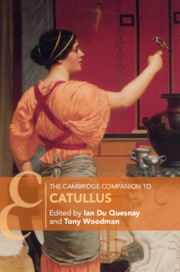Book contents
- The Cambridge Companion to Catullus
- The Cambridge Companion to Catullus
- Copyright page
- Contents
- Notes on Contributors
- Preface
- Introduction
- Chapter 1 Situating Catullus
- Chapter 2 Literary Liaisons
- Chapter 3 Catullan Intertextuality
- Chapter 4 Gender and Sexuality
- Chapter 5 Catullan Themes
- Chapter 6 Language and Style
- Chapter 7 Catullus and Metre
- Chapter 8 Catulli Carmina
- Chapter 9 Catullus and Augustan Poetry
- Chapter 10 Rewriting Catullus in the Flavian Age
- Chapter 11 The Manuscripts and Transmission of the Text
- Chapter 12 Editions and Commentaries
- Chapter 13 Catullus in the Renaissance
- Chapter 14 Catullus and Poetry in English since 1750
- Abbreviations and Bibliography
- Index Locorum
- General Index
Chapter 8 - Catulli Carmina
Published online by Cambridge University Press: 09 April 2021
- The Cambridge Companion to Catullus
- The Cambridge Companion to Catullus
- Copyright page
- Contents
- Notes on Contributors
- Preface
- Introduction
- Chapter 1 Situating Catullus
- Chapter 2 Literary Liaisons
- Chapter 3 Catullan Intertextuality
- Chapter 4 Gender and Sexuality
- Chapter 5 Catullan Themes
- Chapter 6 Language and Style
- Chapter 7 Catullus and Metre
- Chapter 8 Catulli Carmina
- Chapter 9 Catullus and Augustan Poetry
- Chapter 10 Rewriting Catullus in the Flavian Age
- Chapter 11 The Manuscripts and Transmission of the Text
- Chapter 12 Editions and Commentaries
- Chapter 13 Catullus in the Renaissance
- Chapter 14 Catullus and Poetry in English since 1750
- Abbreviations and Bibliography
- Index Locorum
- General Index
Summary
Modern editions of Catullus probably derive, at one or two removes, from a single (now lost) manuscript called the codex Veronensis (V), which returned to or resurfaced in Verona around ad 1300. This text, which marks poem divisions somewhat haphazardly and often wrongly (especially in the elegiacs), was subsequently divided (as conventionally numbered) into c.116 poems. As extant it is a collection of unparalleled diversity: poems range from 2 to 408 lines in length written in a wide variety of metres – lyric, iambic (including choliambics or scazons), phalaecian hendecasyllables, hexameters, galliambics, and elegiacs – and dealing with subjects that include the intensely personal, the quotidian and the exotically mythical, tender expressions of love, jocular amicability and viciously obscene invective in language that reflects as appropriate the gutter, the elevated dignity of epic or the refinement of the self-consciously learned urban elite.
- Type
- Chapter
- Information
- The Cambridge Companion to Catullus , pp. 167 - 218Publisher: Cambridge University PressPrint publication year: 2021

